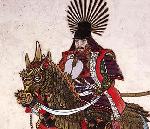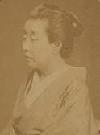WELCOME
Orders over $25 (USD)
Get a 25% DISCOUNT
Japanese Green Tea Shops

1911 - Ryosenji (Ryosen Temple) in Higashiseburi Village, Saga Japan is considered to be the birthplace of Japanese Tea Cultivation. A Zen Priest by the name of Minnan Eisai brought seeds from Sou, China and planted them in the hillsides of the village. It is said that Eisai gave a famous Buddhist Priest named Myokei Shonin three Tea Seeds and taught her how to cultivate them. The cultivation of tea spread north to Suruga (modern day Shizuoka) and became what is now known worldwide as Uji Tea.
1504 - A Ceramist named Koureimin brought "Kama" (ceramic pots) from Ming China, and the method of steaming tea in these pots became widely used in southern Japan. This also marked the beginning of the Ceramic ware Culture in Kyushu, specifically Aritayaki from Arita, Japan.

1593 - During the Momoyama Period (1573-1603), Hideyoshi Toyotomi built the the Nogoya Castle (during his quest to conquer Korea) in Chinzei-cho (in Saga Prefecture). It was in this castle that he created the "Chashitsu" (Tea Room) and refined the austere manner of the "Tea Ceremony." According to the "Nikki", a historical diary of the Merchants of Hakatashi (Fukuoka Prefecture), this room consisted of 4 and a half bamboo mats (Tatami Mats), a bamboo pillar or column and a view of bamboo from the window of the room.

1651 - Samurai Yoshimura Shinbey (a warrior of the Saga Feudal Domain), recommended the clearing of the Mt. Fudou forests in Ureshino town (Ureshino-cho) and began tea cultivation and the developement of the tea industry. Ureshino-cho, considered to have the perfect conditions for growing tea, became the production center for tea in Japan. A "Tea Tree" over 300 years old with a span of more than 80 meters located at Mt. Fudou in Ureshino, stands as a memorial to Yoshimura Shinbey (Father of Ureshino Tea) and is a National Historical Treasure of Japan.

1736 - Kouyugai Baisaou (a Zen Priest) was born in Hasuike town (Saga, Japan) and believed that drinking Green Tea was not only for the elite class, opened the first Tea Shop (Tsusentei) at the age of 64 in Kyoto for the common people. This led to a growing interest among the Japanese in Green Tea, particularly Sencha Tea. He died on July 16th, 1763 at the age of 89 in Kyoto, Japan.
1760 - During the Edo Period (1603-1868) the exporting of Japanese Green Tea had begun. Contrary to common belief, Japanese Green Tea from Saga Prefecture was being exported to Dutch Businessmen (from the port in Nagasaki) as early as 1760. It was 99 years later, (in 1859) that the port of Yokohama was officially open by the Japanese Government to foreign trade.

1853 - A famous female merchant named Oura Kei from Nagasaki is credited as being the Pioneer of Green Tea Exporting. Through a Dutch business firm, she offered samples of Green tea which were passed to America, the United Kingdom and Saudi Arabia. It was an American merchant which placed the first order for 6 tons of tea. In the following years the United Kingdom placed an order for 60 tons. The order was so large that Oura Kei had to collect the Tea from all over Kyushu.